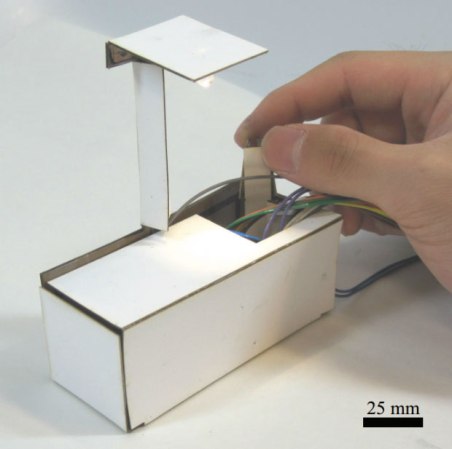
With the advent of 3D printers, printable circuits, and other “one-machine-to-rule-them-all” automated systems, printing fully functional items is fast becoming a reality. The lamp seen above starts out as a flat piece of cardboard with circuits printed onto it — apply some electricity and it will fold itself up, creating a lamp — it even has a capacitive touch sensor for turning it on!
This ingenuity comes straight from Harvard researchers who presented the project “Self-assembling Sensors for Printable Machines” at the IEEE International Conference on Robotics and Automation (ICRA) just last Tuesday in Hong Kong. It’s not fully printable (wires and the LED had to be soldered in by hand) but it’s an amazing proof of concept — there’s also an Arduino off-screen taking care of controlling it.
The cardboard is a sandwich of shape-memory polymers which are triggered by heat, generated by running electricity through thin layers of copper trace. It takes a long time to assemble so the following video has been sped up 32x speed.
Fascinating stuff!
[Via Hacked Gadgets]
















Im gonna clone one of these when I get the time…. seems pretty awesome. Just wonder how much current this contraption draws…
I wonder if anyone has ever created a joint using two pieces of SMA (memory wire).
That could mean 2 things.
I can neither confirm or deny trying both.
Like in SMA driven quadropod or hand?
http://ieeexplore.ieee.org/xpl/login.jsp?tp=&arnumber=4108853&url=http%3A%2F%2Fieeexplore.ieee.org%2Fxpls%2Fabs_all.jsp%3Farnumber%3D4108853
https://www.youtube.com/watch?v=zQih9tLbEzo
Water cooling certain speeds things up, does make it a bit cumbersome though.
I have seen engines and the like using a loop of SMA where movement is caused by heating one side and letting the other air cool. (They’re not very fast)
Now that’d work well as actuators underwater.
Very cool. But, it will unfold itself when it cools down, right?
Not necessary, depends on the material (it may chemically lock itself in its heated shape)
*necessarily
Does anyone have a real-world application for this sort of thing, or is it a solution without a problem?
This is an honest question, not a critique.
I guess you could revolutionize the packaging industry by having stuff pack itself. Unpacking itself would be neat.
Could make flat-pack self-assembly furniture actually live up to its name.
It would certainly make origami easier.
Yes, I have a real world application for this – I sometimes need to assemble equipment at pressures that would kill a human being. The ability to push/slide small pieces around inside a pressure chamber without paying unbelievably high amounts of money would be very valuable to me. So, self-assembly is a great boon for working in hostile environments.
fake. stop motion animation. look at frame 3333. :P
Would be quicker, easier, and give off more light if they would just burn the cardboard.
So it assembles itself, buy using an arduino connected to it?